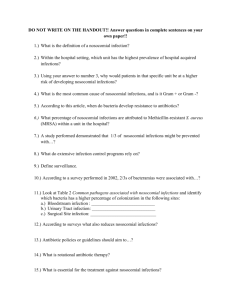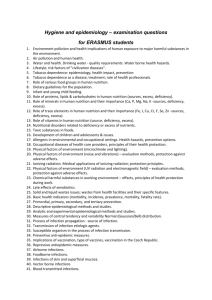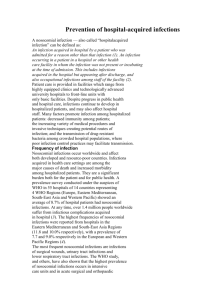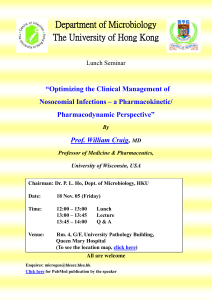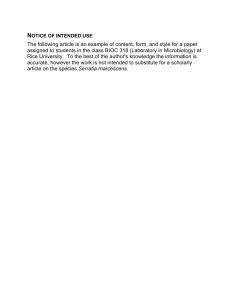Supplemental Exercise #1
advertisement
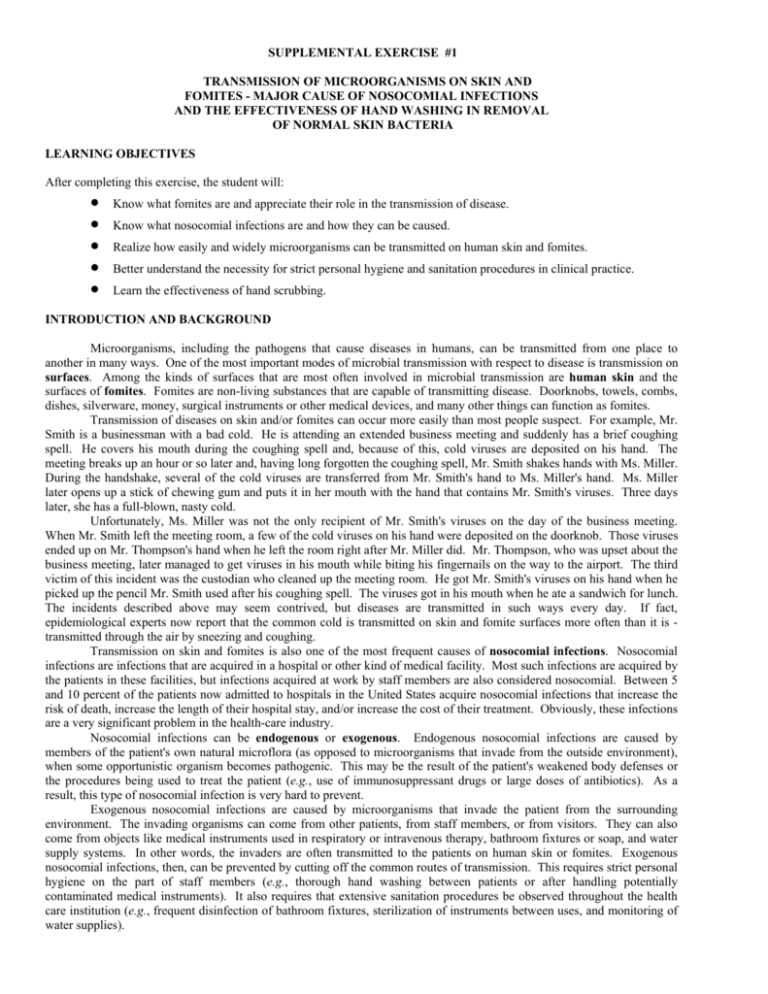
SUPPLEMENTAL EXERCISE #1 TRANSMISSION OF MICROORGANISMS ON SKIN AND FOMITES - MAJOR CAUSE OF NOSOCOMIAL INFECTIONS AND THE EFFECTIVENESS OF HAND WASHING IN REMOVAL OF NORMAL SKIN BACTERIA LEARNING OBJECTIVES After completing this exercise, the student will: • • • • • Know what fomites are and appreciate their role in the transmission of disease. Know what nosocomial infections are and how they can be caused. Realize how easily and widely microorganisms can be transmitted on human skin and fomites. Better understand the necessity for strict personal hygiene and sanitation procedures in clinical practice. Learn the effectiveness of hand scrubbing. INTRODUCTION AND BACKGROUND Microorganisms, including the pathogens that cause diseases in humans, can be transmitted from one place to another in many ways. One of the most important modes of microbial transmission with respect to disease is transmission on surfaces. Among the kinds of surfaces that are most often involved in microbial transmission are human skin and the surfaces of fomites. Fomites are non-living substances that are capable of transmitting disease. Doorknobs, towels, combs, dishes, silverware, money, surgical instruments or other medical devices, and many other things can function as fomites. Transmission of diseases on skin and/or fomites can occur more easily than most people suspect. For example, Mr. Smith is a businessman with a bad cold. He is attending an extended business meeting and suddenly has a brief coughing spell. He covers his mouth during the coughing spell and, because of this, cold viruses are deposited on his hand. The meeting breaks up an hour or so later and, having long forgotten the coughing spell, Mr. Smith shakes hands with Ms. Miller. During the handshake, several of the cold viruses are transferred from Mr. Smith's hand to Ms. Miller's hand. Ms. Miller later opens up a stick of chewing gum and puts it in her mouth with the hand that contains Mr. Smith's viruses. Three days later, she has a full-blown, nasty cold. Unfortunately, Ms. Miller was not the only recipient of Mr. Smith's viruses on the day of the business meeting. When Mr. Smith left the meeting room, a few of the cold viruses on his hand were deposited on the doorknob. Those viruses ended up on Mr. Thompson's hand when he left the room right after Mr. Miller did. Mr. Thompson, who was upset about the business meeting, later managed to get viruses in his mouth while biting his fingernails on the way to the airport. The third victim of this incident was the custodian who cleaned up the meeting room. He got Mr. Smith's viruses on his hand when he picked up the pencil Mr. Smith used after his coughing spell. The viruses got in his mouth when he ate a sandwich for lunch. The incidents described above may seem contrived, but diseases are transmitted in such ways every day. If fact, epidemiological experts now report that the common cold is transmitted on skin and fomite surfaces more often than it is transmitted through the air by sneezing and coughing. Transmission on skin and fomites is also one of the most frequent causes of nosocomial infections. Nosocomial infections are infections that are acquired in a hospital or other kind of medical facility. Most such infections are acquired by the patients in these facilities, but infections acquired at work by staff members are also considered nosocomial. Between 5 and 10 percent of the patients now admitted to hospitals in the United States acquire nosocomial infections that increase the risk of death, increase the length of their hospital stay, and/or increase the cost of their treatment. Obviously, these infections are a very significant problem in the health-care industry. Nosocomial infections can be endogenous or exogenous. Endogenous nosocomial infections are caused by members of the patient's own natural microflora (as opposed to microorganisms that invade from the outside environment), when some opportunistic organism becomes pathogenic. This may be the result of the patient's weakened body defenses or the procedures being used to treat the patient (e.g., use of immunosuppressant drugs or large doses of antibiotics). As a result, this type of nosocomial infection is very hard to prevent. Exogenous nosocomial infections are caused by microorganisms that invade the patient from the surrounding environment. The invading organisms can come from other patients, from staff members, or from visitors. They can also come from objects like medical instruments used in respiratory or intravenous therapy, bathroom fixtures or soap, and water supply systems. In other words, the invaders are often transmitted to the patients on human skin or fomites. Exogenous nosocomial infections, then, can be prevented by cutting off the common routes of transmission. This requires strict personal hygiene on the part of staff members (e.g., thorough hand washing between patients or after handling potentially contaminated medical instruments). It also requires that extensive sanitation procedures be observed throughout the health care institution (e.g., frequent disinfection of bathroom fixtures, sterilization of instruments between uses, and monitoring of water supplies). In this exercise, you will study the transmission of microorganisms on human hands and on a doorknob (a typical fomite). The class will be split into two work groups (Group A and Group B, as designated by your instructor), each of which will examine a different type of transmission. Additionally, you will determine how effective hand washing is by comparing washing with just water and with soap. MATERIALS Culture: Media: Other Materials: Broth culture of Serratia marcescens 2 nutrient agar plates Sterile latex (examination) gloves Sterile cotton swabs Liquid hand soap Doorknob PROCEDURE FOR GROUP A 1. Instructor: Assign numbers to each student in the group, starting with the number 1. 2. All students: Label two nutrient agar plates with the number of this exercise, the date, your name, your section number, your group letter (A or B), and your number within the group (e.g., "student no. 1"). 3. All students: Label one of the plates from step 2 ‘before ’, and the other ‘after ’. 4. All students: Place a sterile examination glove over your right hand, being careful not to contaminate the fingers of the glove as you do so. NOTE: Throughout the rest of the exercise, it is very important not to touch anything with your gloved hand except when specifically told to do so in the instructions given below. 5. Student No. 1: Using a sterile cotton swab, smear some of the Serratia marcescens culture over the fingers of your gloved hand. 6. All students: Shake hands in sequence, starting with student no. 1. (In other words, student number 1 should shake hands with student number 2, student number 2 should then shake hands with student number 3, etc.) NOTE: Shake hands by clasping the fingers, rather than the palms of your hands. Your instructor will demonstrate the best way to shake hands for this exercise. 7. All students: Gently smear the fingers of your gloved hand all over the surface of the agar on the plate labelled ‘before’ . 8. All students: Thoroughly wash your hands with the disinfectant soap that is provided for this purpose . Do not dry your hands with paper towels but shake off the excess water. 9. All students: Gently touch the fingers of your gloved hand to the surface of the agar on the ‘after’ plate that you labeled in step 3. 10. All students: Carefully remove the glove from your hand and discard it in the designated container. 11. All students: Invert the plates and incubate them at 25o C until the next lab period. PROCEDURE FOR GROUP B 1. Instructor: Assign numbers to each student in the group, starting with the number 1. 2. All students: Label two nutrient agar plates with the number of this exercise, the date, your name, your section number, your group letter (A or B), and your number within the group (e.g., "student no. 1"). 3. All students: Label one of the plates from step 2 ‘before’; label the other plate from step 2 ‘after.’ 4. All students: Place a sterile examination glove over your right hand, being careful not to contaminate the fingers of the glove as you do so. NOTE: Throughout the rest of the exercise, it is very important not to touch anything with your gloved hand except when specifically told to do so by the instructions given below. 5. Student No. 1: Using a sterile cotton swab, smear some of the Serratia marcescens culture over the fingers of your gloved hand. 6. All students: Firmly grasp and turn the doorknob (designated by your instructor) in sequence, starting with student no. 1. (In other words, student no. 1 should grasp the doorknob first, student no. 2 should grasp the doorknob after student no. 1, student no. 3 should grasp the doorknob after student no. 2, etc.) 7. All students: Gently rub the fingers of your gloved hand to the surface of the agar in the ‘before’ plate . 8. All students: Thoroughly wash your hands with the disinfectant soap that is provided for this purpose but do not dry your hands with paper towels. Shake off the excess water. (Keep the glove on your right hand as you do this.) 9. All students: Gently touch the fingers of your gloved hand to the surface of the agar on the plate labelled ‘after’ plate that you labelled in step 3. 10. All students: Carefully remove the glove from your hand and discard it in the designated container. 11. Instructor: Thoroughly disinfect the doorknob used for this part of the exercise! 12. All students: Invert the plates and incubate them at 25o C until the next lab period. Observations and Results Supplemental Exercise 1 RESULTS 1. Examine the plates for the presence of Serratia marcescens colonies (which will be pink or red). You may ignore any other types of colonies that are present. 2. Enter your results in the table on the blackboard, as directed by your instructor. 3. When the table is complete, copy the results into the following table: GROUP A GROUP B Growth on plates Growth on plates Student: before washing No. 1 No. 2 No. 3 No. 4 No. 5 No. 6 No. 7 No. 8 No. 9 after washing before washing after washing QUESTIONS 1. Did group A find evidence for transmission of the Serratia marcescens on human hands? Why or why not? If evidence for transmission was found, how extensively was the bacterium transmitted? 2. Did group B find evidence for transmission of the Serratia marcescens on a fomite (the doorknob)? Why or why not? If evidence for transmission was found, how extensively was the bacterium transmitted? 3. Did hand washing with disinfectant soap effectively remove Serratia marcescens from your gloved hand in this exercise? 4. Would Group A's results be different if student no. 1 had washed his or her hands before shaking hands with student no. 2? If your answer is yes, describe how the results would be different. 5. What are fomites and why are they important with respect to nosocomial infections? 6. Are fomites important sources (or causes) of endogenous nosocomial infections? Why or why not? 7. Do the results of this exercise make a case for thorough hand washing with soap to lower the rate of infection by fomites?

